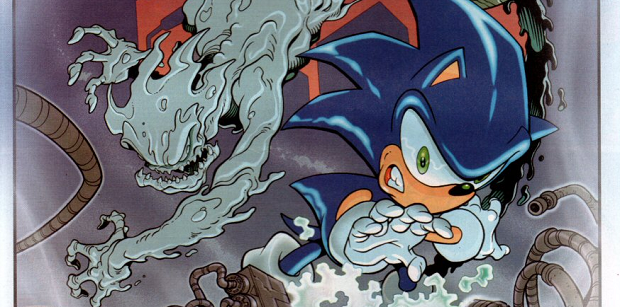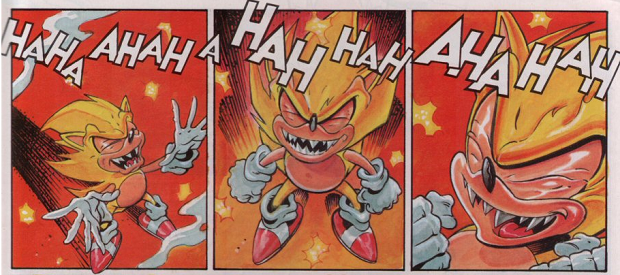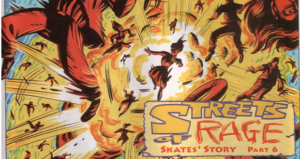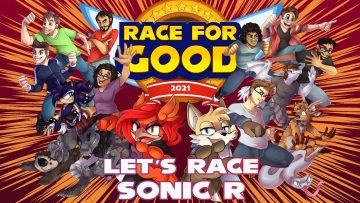
Vertical Slice: Remembering Sonic the Comic
I’ve been thinking about Sonic the Comic lately.
Not the glossy new Archie publications, but the tattered, 9″ x 12″ pages of recycled paper bound and wrapped in a shopping bag somewhere under my bed. Dusty, but not forgotten.
I drag them out from time to time, once every year or so, prompted by childhood memories of newsagents, pocket money and after-school afternoons spent huddled by my bedroom radiator. But this time the thought of revisiting my comics came in a more roundabout way.
Last week, Archie’s Sonic the Hedgehog lead writer Ian Flynn revealed that Madonna―a human character originally intended as Sonic’s girlfriend during Sonic 1‘s conception―will be appearing in the comic.
She’s an interesting choice, and I was surprised that the fellows at Archie would think to pluck such an obscure character from so far back in Sonic’s history. I found myself wondering how Archie would do it―how would Flynn and the rest of the Sonic the Hedgehog gang work a 25 year old unused character into the comic’s sprawling and fragmented continuity? Then I remembered all the weird and wonderful adaptations of videogame characters and concepts over the years. Then, finally, I remembered the time Chaos appeared out of nowhere, absorbed Sonic, turned his eyes green, and murdered Johnny Lightfoot.
 Sonic the Comic first appeared in British newsagents in May 1993 Year, and boasted four short stories per fortnightly issue, spanning a range of popular Sega games including Shinobi, Golden Axe, Wonder Boy, Ecco the Dolphin and more. It had a solid run of 223 issues over nine years, with the first 184 of these containing new material before the then publisher, Egmont Magazines, turned to reprints.
Sonic the Comic first appeared in British newsagents in May 1993 Year, and boasted four short stories per fortnightly issue, spanning a range of popular Sega games including Shinobi, Golden Axe, Wonder Boy, Ecco the Dolphin and more. It had a solid run of 223 issues over nine years, with the first 184 of these containing new material before the then publisher, Egmont Magazines, turned to reprints.
My first issue was issue #127, April 1998, bought for me by my parents from our local Sainsbury’s for a grand total of £1.25. It featured the final part of a story in which a power hungry Robotnik had absorbed the power of the chaos emeralds, inadvertently transforming himself into solid emerald.
I was nine years old, and on the first page of my new Sonic comic, Robotnik had not only been defeated, but he was effectively dead.
It blew my mind.
With no Robotnik, and no new Sonic games to draw from, the comic’s writers were free to expand on their vision of Mobius as they saw fit, and fortnight after fortnight I was treated to original adventures featuring my favourite videogame characters that weren’t rehashes of what I’d seen on my Mega Drive.
And I loved it.
But I don’t enjoy my old issues of Sonic the Comic like I used to. The majority of stories are comedy-focused, containing a slew of cringe-worthy and unappealing British puns in the same vein as The Beano or The Dandy. Also, later issues of the comic contained a greater number of the aforementioned reprinted material, which were often less inspired than the more modern stories.
 But what I do find interesting are each issue’s featured story, in which writers Nigel Kitching, and to a lesser extent Lew Stringer, told non-condescending, multi-parted children’s stories with surprising levels of conflict and seriousness. For example, in the popular “Running Wild” story, starting in Sonic the Comic #80, Sonic’s psychopathic alter ego Super Sonic decides to kill Amy Rose. He’d stopped before he does, of course, but the murderous intent and capability was there―Super Sonic was a scary monster that didn’t simply want to “defeat” or “destroy” Amy, he wanted to kill her.
But what I do find interesting are each issue’s featured story, in which writers Nigel Kitching, and to a lesser extent Lew Stringer, told non-condescending, multi-parted children’s stories with surprising levels of conflict and seriousness. For example, in the popular “Running Wild” story, starting in Sonic the Comic #80, Sonic’s psychopathic alter ego Super Sonic decides to kill Amy Rose. He’d stopped before he does, of course, but the murderous intent and capability was there―Super Sonic was a scary monster that didn’t simply want to “defeat” or “destroy” Amy, he wanted to kill her.
This approach to writing Sonic the Comic‘s featured stories is summed up well by Lew Stringer in an email to Sonic the Comic Yahoo Group member “Doctor Zachary”:
The American Sonic comic may be aimed at readers over 12, but the UK edition is essentially a children’s comic, and we have to appeal to the majority of readers, who are around five to ten year olds … having said that, it doesn’t mean we can be sloppy because we’re “just” writing for kids … my criteria is always the same; keep to the stories own internal logic, and above all, make it entertaining.
As well as Nigel Kitching in his issue #223 farewell article:
I … made an effort to have my stories be pretty serious rather than humorous. I knew that the readers took Sonic seriously, no matter how cute he may have looked. Cute or not he was still the hero.
Also interesting is the comic’s history, both on its own and as a weird, distant cousin of popular British comic 2000AD. Both titles originally shared the same same publisher, Fleetway Editions, used the same anthology format, and shared the same staff including Richard Elson, Mick McMahon, Andy Diggle and even a fledgling Mark Millar.
A series of buy-outs and mergers would see Fleetway become part of The Egmont Group, and in 2000, 2000AD and its associated properties were sold to videogame developer Rebellion, where it continues to thrive to this day. Sonic the Comic wasn’t so lucky, ending with issue #223 in January 2002. However to most fans, Sonic the Comic truly ended with the controversial issue #185―the first issue to contain nothing but reprints.
In another email to the comic’s unofficial Yahoo Group, Kitching suggests that Sonic the Comic staff were informed about the switch to reprints, and their lack of a job, at very short notice. As a result, the comic’s final original story, inspired by Sonic Adventure, was cut short, ending with a rushed deus ex machina and a shed full of loose ends. Strangely enough, this happened only six weeks and three issues after buying my last issue, #181.
These are all reasons why Sonic the Comic is interesting to me, and I don’t expect the same level of interest to be held by the average, non-British Sonic fan. That said, I’d suggest that Sonic the Comic has an even greater importance in videogame history as a whole, by being one of the greatest examples of the branding of a videogame franchise differing not only between regions, but between individual countries.

According to Kitching, again via the comic’s Yahoo Group, Fleetway staff were given very little in the way of guidance or restrictions by Sega Europe when creating new Sonic fiction aside from British guidebook Stay Sonic, and a vague push towards the “freedom fighter” trope. Note that the first issue of Sonic the Comic to feature said trope was issue #8, and was written without any knowledge of Sonic SatAM, and was in fact published two weeks before the cartoon’s first episode in the US. This resulted in the creation of a distinct continuity, different to that of Sega of America and Sega Japan’s vision of Sonic. A continuity where Sonic’s an arrogant prick, Amy’s a strong willed inter-dimensional planet hopper, and everyone hates Charmy Bee.
Back then, Sega wasn’t yet concerned with the integrity of the Sonic brand on a global scale, it simply wanted those brands to grow. But in today’s age of constant, worldwide interconnectivity, Sonic’s global image is strictly controlled―where ever you are in the world, official Sonic merchandise will always depict him, and his “retro” and Sonic Boom incarnations, in exactly the same way. Never again will we see multiple, officially endorsed, country specific versions of the same incarnation of Sonic existing simultaneously―Britain will never have another Sonic the Comic.
I can’t bring myself to throw those tatty old comics away, but some day I might. Someday the rest of the British, twenty-something year old Sonic fans might through their dusty, unread piles of Sonic the Comic away as well. And that worries me, because I don’t think Sonic the Comic deserves to be washed aside by the tides of time. There’s no legitimate method of reading old issues outside of eBay. The the comic’s fan-run successor Sonic the Comic Online can’t offer old material either for obvious reasons. And while I assume Sega technically own the rights to the strips, seeing as how they’re officially licensed, I don’t seem them or Egmont releasing collections any time soon, despite an unrelated publishing deal being signed between the two in 2013.
No, I truly do not think Sonic fans should let Sonic the Comic be forgotten, if not for its historical significance, then for its stories―its good stories. Because when Kitching sent a script to Richard Elson, or Stringer to Bob Corona or Nigel Dobbyn, magic would happen.
 I couldn’t end this article without mention of Archie’s Sonic comics. Not because of their quality―I can’t comment, I’ve barely read them―but because they’re truly the last remnant of not only the old, intra-regional Sonic identities, but of any major videogame franchise. Of course, we all know that what happens in the comics, stays in the comics, but for what started as a tie-in to a spin-off, Archie’s Sonic the Hedgehog has persisted for a remarkably long time. In that time the comic’s seen new characters come, go and forcibly removed, it’s created its own spin-offs in Knuckles the Echidna and Sonic Universe, and has even had its fair share continuity-altering events (it wouldn’t be an American comic book series without them).
I couldn’t end this article without mention of Archie’s Sonic comics. Not because of their quality―I can’t comment, I’ve barely read them―but because they’re truly the last remnant of not only the old, intra-regional Sonic identities, but of any major videogame franchise. Of course, we all know that what happens in the comics, stays in the comics, but for what started as a tie-in to a spin-off, Archie’s Sonic the Hedgehog has persisted for a remarkably long time. In that time the comic’s seen new characters come, go and forcibly removed, it’s created its own spin-offs in Knuckles the Echidna and Sonic Universe, and has even had its fair share continuity-altering events (it wouldn’t be an American comic book series without them).
Now Archie’s throwing it all together with Mega Man, Sonic Boom, Madonna (my guess) and more with Worlds Unite for a full-on Crisis on Infinite Earths-style event.
Good luck to them…
—
Believe it or not, Michael Westgarth is a Sonic fan just like you! Read his previous columns via his author page and check out his blog at MegaWestgarth for more Westgarth goodness.



![Private: [ID: OtByE7Fcfso] Youtube Automatic](https://lastminutecontinue.com/wp-content/uploads/2024/05/private-id-otbye7fcfso-youtube-a-360x203.jpg)


